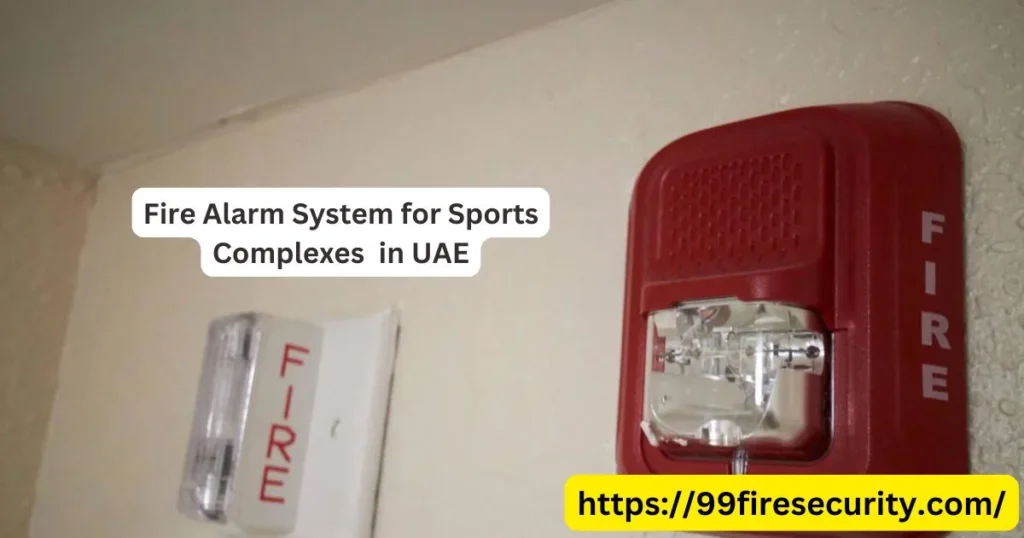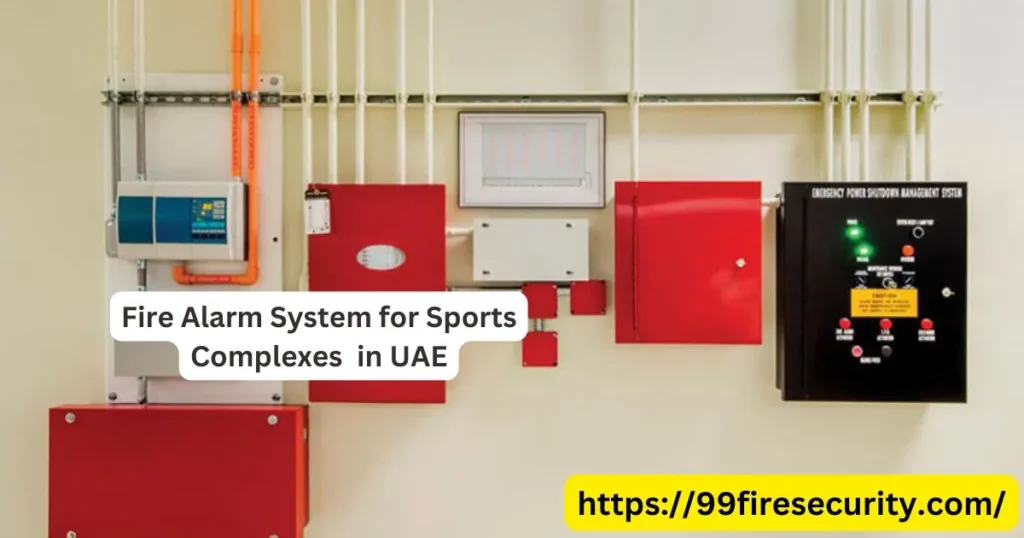Fire safety, therefore, is one of the most important aspects of managing sports complexes, particularly in the UAE, where hundreds of thousands of fans flock to stadiums, arenas, and fitness centers. A fire alarm system works on the well-being of individuals. The combination of large crowds, electrical equipment, and kitchen facilities makes sports complexes vulnerable to fire risks. The safety of athletes, spectators, and staff may be compromised without the proper fire alarm systems.
“Because sports complexes boast large, open spaces and multiple levels, detecting a fire can be difficult. For example, the materials used in buildings such as rubber flooring, gym equipment, and electrical wiring can promote the fast spread of the flames. So, if you can install a fire alarm system, it can prevent potential disasters and will save lives.
Fire Alarm System Regulatory In UAE
To ensure the safety of their citizens, the UAE government places fire safety as a top priority and has the UAE Fire and Life Safety Code of Practice in place. This code requires sports complexes to comply with fire safety standards, such as certified fire alarm systems. Other fire safety guidelines are imposed by each emirate which varies from other emirates including Dubai and Abu Dhabi for businesses to ensure compliance across public venues.
Fire risk assessments need to take place at sports complexes regularly with full checks that all alarm systems are correctly up to date and functional. Spatial temporal data trends, which help in enforcing orders can also aid in controlling non-compliance which can lead to fines or closures. Hence, familiarization with these regulations, along with their incorporation during the design and construction of sports facilities, is of crucial importance.

Essentials of a Fire Alarm System
The most reliable fire alarm system includes the following key components:
- Detection Systems – Smoke detectors, heat sensors, and flame detectors are designed to recognize fire outbreaks in their early stages.
- Notification Devices — Sirens, strobes, and flashing lights alert people within a wide area, facilitating a quick evacuation.
- Control Panels – The system brain that monitors every device and triggers the alarm when necessary.
- Monitoring Systems – This offers remote monitoring, sending alerts to emergency services, even when the facility is unoccupied.
Fire protection devices should be periodically evaluated, maintained, and repaired if necessary, resulting in a multi-layered approach to fire outbreaks within these sports complexes.
Types of Fire Alarm System for Sports Complexes
There are different types of fire alarm systems that serve the particular needs of sports complexes. Choosing the right system helps ensure full coverage and efficiency:
- Conventional Systems – Designed for smaller sports facilities where the zones are passed in manual checking during the alarm.
- Addressable Systems – Best suited for large complexes where each detector has its own address which helps in easily locating the site of the fire.
- Wireless Systems – These systems can make installation a matter of minutes, thus cutting back on wiring, making them perfect for temporary sports venues or retrofitting.
The size and layout of the complex, as well as budget considerations, help dictate the suitable fire alarm system.
Fire alarm system design for large sports venues
The first step in designing a fire alarm system is knowledge of the layout of the facility. A risk assessment identifies potential fire hazards — putting you in the best position to find where to put detectors and alarms. A big sports venue is divided into zones so nothing escapes coverage.
Here are some of the main design considerations:
- Zoning – Dividing the venue into independent zones to increase fire detection accuracy.
- Exit Coverage — Keeping alarms loud enough by exits plus stairways to guide evacuees.
- Integration of Emergency – Connecting to emergency lights, PA systems, and sprinklers.
Best practices in fire alarm design minimize false alarms and increase response time in emergencies.
Fire Alarm Systems Installation Steps
Information is up to date as of October 2023. It starts with site evaluation and planning, to choose the proper equipment, and install and arrange components at some strategic locations.
Installation Process: Steps
- Site Preparation – Engineers evaluate the building for low and high-risk sections, as well as potential locations for detectors and alarms. That includes exits, kitchens, and spectator stands.
- Setting Up Equipment Detectors, sirens, control panels, and monitoring systems are being installed. Particular focus is given to large open bodies and places where fire could ignite without baiting.
- Wiring and Connectivity – Inthe case of a wired system, cables are pulled to allow for intercommunication among all elements. Detectors are synced with control panels in wireless systems.
- Device testing and adjustment – Every device is tested to make sure it reacts accurately to the stimulation of fire, without programming false alarms. Calibration makes detectors sensitive to changing levels of smoke and heat without false triggering.
- Handover and Training – After it has been installed and is ready, the system is handed over to the management, and the staff are trained in how to operate and respond to alarms. Fire safety education is supplemented with drill and emergency procedures.
Proper installation is very important to enable the system to work during emergencies. Audits during the process help prevent errors and delays.
Inspection, Testing, and Maintenance of Fire Alarm Systems
In this regard, it is vital to keep fire alarm systems functional. At sporting complexes, where thousands of people congregate, a faulty alarm system could have catastrophic results.
Normal Maintenance Schedules:
- Monthly Testing — A regular department that the detectors, sirens, and control panels are operational.
- Annual Servicing — A more comprehensive check-up, where professional servicing groups ∣ recalibrate detectors and change out defective parts.
- Record Keeping– Logs are kept by end-users that monitor system performance, repairs, and upgrades, thereby fulfilling UAE compliance.
Besides routine training, impromptu fire drills evaluate the system in real-life situations, giving further insight into its functioning and where its weaknesses lie.
State Of The Art Technologies In Fire Detection
Fire detection and response solutions are being powered to a greater degree than ever in sports complexes in the UAEDuring large events, when thousands of spectators gather in one venue, the risk of fire-related incidents increases exponentially. Advancements such as artificial intelligence (AI) and the Internet of Things (IoT) are converting traditional systems into smart, responsive systems.
Important Technologies Used in Today’s Fire Alarm Systems:
AI-Based Detection – By identifying patterns of smoke and heat, AI is able to reduce false alarms by recognizing innocuous smoke (steam) and differentiating it from actual fires.
- Integration with IoT – Sensors relay information to IoT platforms to enable the real-time monitoring of various parameters and alerting of facility managers or emergency responders instantly.
- Remote Access – Mobile apps allow remote control and monitoring of fire alarm systems, enabling rapid response when a facility is unmanned.
Such technologies boost fire safety while allowing buildings to function more effectively, ensure business continuity, and support complex operations.
A few of the challenges faced in the implementation of Fire Alarm Systems in sports complexes
Fire alarm systems are an important system yet can be difficult to implement in large sports complexes. A key challenge is also redeploying the public order in vast open spaces such as stadiums or arenas where the sonorous and luminous messages may not cover all the areas.

Key Challenges:
- Broad Area Coverage – One of the challenges is to ensure complete coverage of the detection area with the absence of blind spots, which can be complicated and expensive.
- Minimal disruption – The installation and testing of systems must be carefully scheduled to avoid disruption to any ongoing sports events or training sessions.
- Alarms should be oriented for large crowds of people moving to exits, while preventing panic or crowd-crush.
To address these challenges, many sports complexes turn to specialized fire safety solutions designed to cater to their unique layouts and operational requirements.
Fire Drills and Evacuation Plans
Fire drills are essential for guaranteeing effective function of fire alarm systems at times of emergencies. Persistent drills allow the staff and visitors to know the importance of evacuation which assists to limit injuries or upheaval during a live fire circumstances.
Key Factors of Effective Fire Drills:
- Clear Evacuation Routes: All exit points are marked and paths are kept clear of obstructions
- Communication Systems – PA systems enable clear and concise instructions to guide crowds to the nearest exits.
- Role Assignments – Staff have roles, including helping to organize crowds, others cutouts for the elderly or persons with disabilities, others have tables for emergency supplies.
These also are updated to suit changes an in the way facility layout or capacity works so they are permanent feature of ongoing preparedness.
Importance of Fire Alarm Systems in Crowd Management
One of the critical responsibilities of sports complexes is to manage large crowds during emergencies. Crowd guidance and control through fire alarm systems Crowds are managed with the help of alarm systems. People are steered through exits by automated voice announcements and flashing signals, reducing panic and helping manage orderly evacuation.
Advantages of Crowd Management Systems:
- Reduced Panic – Clear, automated instructions allow people to remain calm and do what they have to.
- Efficient Evacuation – Well-placed alarms and strobes guide individuals to the closest, safest exit point.
- Accessible Alerts – There are also visual signals (for example, flashing lights) so that hearing impaired individuals are also alerted.
When integrated with crowd management tools, fire alarm systems contribute to enhanced overall safety in sports complexes.
Costing and Budgeting of Fire Alarm Systems
Although installing a fire alarm system requires a considerable financial investment, the dividends in the long term will far outweigh the initial outlay. Budgeting for these systems consists of determining equipment costs, installation charges, and maintenance expenses.
Cost Breakdown:
- Oversees – Smoke detectors, control panels, sirens, and monitoring software.
- Installation, which is the labor, wiring, and integration into existing systems
- Maintenance – Routine maintenance, parts replacement, and upgrades.
Even more so, high-end systems may set you back a little more up front, but they are much safer and have less operational risk.
Sports complexes in the UAE that have fire alarm systems installed: Successful case studies
Most of the sports complexes in the UAE use sophisticated fire alarm systems. Moreover, a number of important venues such as Dubai Sports City and Zayed Sports City also have advanced detection and evacuation systems and other measures to help ensure maximum safety during events.
Lessons Learned:
- Life-Saving Early Detection — Rapid-response systems mitigate damage and avoid casualties.
- Customization is Key – Tailored nature of solutions ensure that all the ends of the complex is covered.

Effects of Environmental Factors on Fire Alarm Systems
The UAE’s extreme climate, with soaring heat levels and humidity, does impact fire alarm systems. Dust and sand that accumulates on optics such as detectors can cause false positives or sensorial fatigue.
Solutions:
- Durable Equipment – High-temperature and humidity-proof fire alarm systems can be adopted for long-term use.
- Regular Cleaning – Detectors undergo frequent cleaning and servicing in order to prevent dust buildup.
The Final Word and Upcoming Fire Alarm Systems in UAE
We have seen how the development of fire alarm systems, which continue to evolve with new technologies and safety regulations, can bring new trends to UAE sports complexes. With the country set to host additional global sporting events, the importance of investing in efficient fire safety cannot be overstated.
Implementing intelligent systems and proactively implementing regular servicing to enhance safety for athletes and spectators alike will help sports complexes mitigate risk, solidifying the UAE’s status as a premier location for globally recognised sporting events.
FAQs
In a large stadium, which fire alarm system is best?
Given that these systems can identify the location of fire, addressable fire alarm systems are ideal for large stadiums.
Is it mandatory to have fire drills in sports complexes?
Yes, UAE regulations require regular fire drills that enable both staff and visitors to be prepared.
Are smoke alarms able to identify false alarms?
By developing systems using AI and IoT, the false alerts can potentially cut down to half by analyzing the fire pattern.
What function do PA systems serve a fire emergency?
Mass notification services deliver P.A. announcements that relay essential evacuation directions and direct a stampede of bodies toward safety in a fire.


